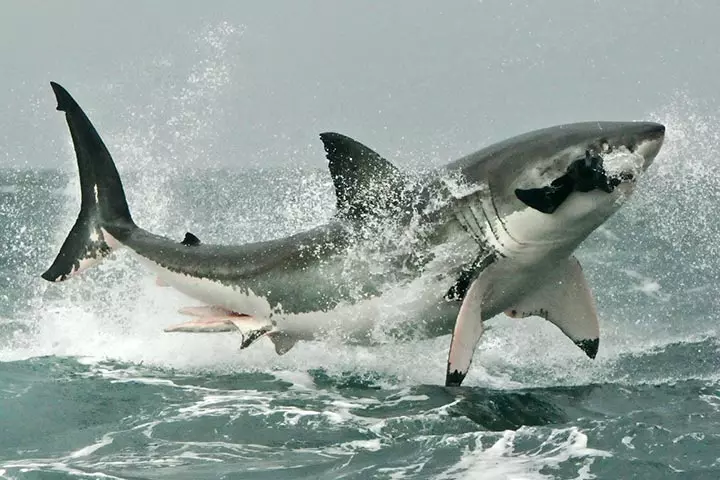

Image: Shutterstock
Sea animals are an interesting learning topic for children. They love learning about them, and their curiosity is ever-increasing. So here we bring you some interesting great white shark facts for kids. Kids find sharks fascinating and are amazed by their size. Our list includes various fun and educational facts that will keep your child engaged for hours. So, encourage your child to learn more about these great animals. Read on to learn more.

Great White Shark Information For Kids
1. What Is A Great White Shark?
- The Great White shark, scientifically known as Carcharodon carcharias, is one of the biggest, most feared, and aggressive species of sharks.
- Great whites are much older than dinosaurs. They have been inhabiting this blue marble for more than 400 million years. This species of shark has adapted perfectly to marine life. In fact, the shark is a large lamniform shark i.e. it has a dorsal fin on its back and two fins on its sides.
- The monster shark is also widely famous as the top predator and the most successful hunter in the ocean. Humans are the only threat to them (1).
2. What Is The Size Of Great White Sharks?
- Being the world’s largest predators, Great Whites are enormous in size i.e. as long as 15 to 20 feet.
- This giant shark weighs about 2,260 kilograms i.e. 5,000 lbs.
- Females great whites are much larger than males.
- The biggest Great White is about seven meters long and weight two to three metric tons i.e. 6,500 pounds.
3. Habitat Of The Great White Sharks:
- You can find Great Whites in the coastal surfaces of every ocean on the Earth.
- The shark prefers to live in salty, temperate coastal seas.
- Prominently, you can find Great Whites along the coasts of South Africa, Australia, northeastern USA, and California. Also, a few Great Whites thrive around the Brazil, Caribbean, Azores, Mauritius, the Seychelles, Sri Lanka, Hawaii, Philippines, New Caledonia, Japan, Gulf, and Madagascar.
- Great Whites swim not only on the surface of the water but can also dive as deep as 820 feet deep in water. Their upper gray colored body blends well with the rocky seafloor at the coast (2).
4. What Do Great White Sharks Eat?
- Great White sharks devour a vast variety of food. They are meat eaters who like to eat fishes and other sharks in the ocean.
- Even though the sharks like to hunt and eat their food, they eat whatever comes their way. Matured great whites tend to consume sea lions, sea turtles, seals, and turtles if they come around. They have an enormous appetite, and they can eat an entire sea lion in a single meal.
- Young sharks prefer to feed on fishes and rays.
- If live fishes are scarce, great whites may also to eat dead animals lying in the oceans. They use their sharp teeth to penetrate whatever they find, tear apart the meat and bones, and satisfy their appetite. This shark does not chew the food; it just swallows it.
- A big meal can fulfill a great white shark’s body functional requirements and sustain it for about two months.
5. Anatomy Of Great White Sharks:
The Great White Sharks feature a unique anatomy that distinguishes them from the rest of the fishes. Here, we list some peculiar anatomical features of the shark.
1. Shape And Color:
Great white sharks possess a bullet-shaped or a torpedo-like body with gray, brown, or black skin and a white belly. The unique coloration is an excellent camouflage that helps the shark as it hunts prey, helping the shark camouflage itself from its prey.
2. Teeth:
Great Whites have over 300 triangular, serrated, razor sharp teeth in about seven rows in its mouth. Their teeth are about three inches long. Ouch!
3. Nose And Mouth:
Great white sharks possess a pointed nose on its face. Their mouths extend well beyond their eyes.
4. Tail:
The Great White Shark has a unique tail structure. The upper part of the body is longer than its bottom. The unusual design and crescent shape of the tail help the shark balance well and minimize friction as it moves through the water. The tail of a Great White is powerful enough to help propel it through the water at speeds reaching close to 15 miles per hour.
5. Fin:
Great whites possess a dorsal fin that you can see above the water when it swims near the water surface. If you do spot a dorsal fin swimming towards you, consider getting out of the water as soon as possible.
6. Gill:
The Great White Shark has five gill slits.
7. Tongue:
Great Whites have a tongue of basihyal cartilage, and they use it to examine their prey and decide whether it is good enough to eat it or not.
8. Skin:
Usually, a shark’s skin is full of dermal denticles that feel like rough sandpaper (3).
6. Does A Great White’s Teeth Rotate And Replace A Lost One?
Yes, the sharp, serrated teeth of the shark rotate and replace the lost teeth according to the Shark’s needs. The Great White uses the first two rows of teeth for grabbing and cutting its prey. If the shark loses one of its teeth while feeding or fighting, the tooth behind it comes forward and replaces the lost tooth. Great Whites lose and regenerate thousands of teeth several times throughout their life. Saves them a trip to the dentist, eh?
7. Do Great White Sharks Have Eyelids?
No, just like many other fishes, Great White sharks have no eyelids. So, they roll their eyeballs into their sockets to prevent the risk of eye injuries while battling or attacking their prey. Rolling the eyeballs is a common practice of the shark to protect eyes while attacking a sea lion, as sea lions possess sharp claws that may harm the shark. The great white turns practically blind in the last moment of the battle. However, the shark has excellent eyesight at all other times.
8. Incredible Smelling Sensation Of Great White:
- Great whites are well-known for their excellent sense of smell, as they can feel the aroma of a drop of blood floating in ten billion drops of water or 25 gallons of water. They have their nostrils beneath their snout. Their nostrils connect to an organ known as an olfactory bulb.
- Great whites possess the largest olfactory bulb among all other kinds of sharks.
- If you drop a drop of blood three miles away from the shark, it can easily smell and detect it.
9. Acute Vision Of Great White:
Great white sharks have excellent eyesight and vision. The retina of their eye has two areas such that one retinal area aids the shark to view during the daytime while the other area helps it see at the night and in low light. So, great whites can see during the daytime as well as in the dark environments at night.
10. Unique Hearing Power Of Great White:
- The external ears of a Great White shark are difficult to locate, as its ears are simply two small openings present above and behind its eyes. Even though the shark has small ears, they are incredibly powerful. Internally, their ears have cells that can easily sense even the slightest vibration in the surrounding water.
- Besides, great whites also possess an ‘ear stone’ that responds to the Earth’s gravity providing the shark hints to help it learn where it lies in the water i.e. right side up, head up, head down, or upside down.
11. Distinguished Sense Of Taste Of Great White:
Great whites have an enormous appetite and brilliant sense of taste that make them opportunistic eaters. Their taste buds are present inside their throats and mouth, so they can identify the food before they swallow it. Taste buds help sharks differentiate between edible and inedible food and choose the right one. They hunt sea lions, seals, fishes, squids, and other species of sharks depending on the season.
12. Excellent Electro-Reception Power Of Great White:
- One of the most impressive powers of the great whites is their brilliant ability to sense electric fields.
- The shark’s snout is full of series of pores that contain cells known as Ampullae of Lorenzini, which feel and detect the direction and power of various electric currents.
- Sharks can detect electrical currents of their prey that helps them locate their food even under the sand of the ocean floor and in the crevasses. They use their electro-reception power to navigate through open seas following the map of magnetic fields that rub over the earth’s crust.
- Their incredible electro-reception power helps them sense a half a billionth of one volt easily.
- If you are in the ocean and remain still, still the shark can detect your heart beating even if it’s present several miles away.
13. Commendable Touch Or Tactile Sensation Of Great White:
- Great white sharks have an incredible sense of touch that operates via their lateral line, which extend along the length and within the shark’s body from its tail to head. The lateral line is full of cells that can detect vibrations in the ocean and locate their prey.
- Great whites can detect both the direction as well as the amount of movement of their prey.
- So, sharks can detect their prey even when it’s about 820 feet away from them (4). All these highly adapted senses and peculiar body structure make Great White sharks the most successful hunter in the ocean.
14. Are Great White Sharks Intelligent Sea Animals?
Yes, Great whites are very smart and inquisitive aquatic animals. They have a large brain which coordinates with all its supremely adapted senses. These sharks exhibit different behavior, such as gaping at one another by opening their mouth, co-operating each other, hunting in groups, assertive body slams, and outsmarting their prey. Besides, researchers state that the Great Whites have incredible quick learning skills.
15. How Fast Do Great White Sharks Swim?
- Great Whites can swim at speed on 35 miles per hour i.e. about 50 kilometers in an hour. These sharks migrate long distances.
- Some of the long journeys of Great Whites include swimming from the Hawaiian Islands to California.
- A Great White swam from South Africa to Australia is the longest migration record among the fishes.
16. Hunting Behavior Of Great Whites:
Great White sharks are smart ocean hunters, and they use specific strategies to get hold of their prey. While stalking their prey, the sharks use the element of surprise and swims below their targets before swimming upwards at a fast speed. Then the shark bursts out of the water and lands back in ocean holding its prey in its mouth.
Image: IStock
17. Are Great White Sharks Social And Do They Fight With Each Other?
- Most Great White sharks are loners. However, some of them travel in a group known as shoal or school.
- If the shark wants to grab other’s prey or it has food enough for only one shark, then both the sharks feature slapping demonstration to discourage each other. They display tail-slapping fight and hit the sea surface as they swim around each other. The tail slapping sends a spray of water in the direction of the opposite, and the shark who slaps greater than other wins the prey. However, Great Whites avoid fighting with each other because just one bite can permanently disable the shark.
18. Does Great White Shark Eats Humans?
- Sharks attacking humans is a rare occasion, and most fatalities are due to the blood loss and not because shark consumes the individual. Even though Great White sharks attack humans, they do not eat them. Humans have too many bones for the Great Whites to digest and minimum fats for a shark.
- Sharks make just five to ten attacks on humans every year. They exhibit a test biting behavior. The fact is that a Great White shark attacks human when it thinks that your silhouette is a seal. However, when the shark discovers that you are not the sea seal, it retreats instantly and never returns again to consume the attacked individual. Humans possess a very little amount of fats than what sharks need to meet their requirements. So, they always consume large, fatty animals and have no interest in eating humans.
19. Do Great White Sharks Sleep?
- Great White sharks don’t sleep like humans and other animals, as they must keep moving to stay alive. Sharks exhibit spans of inactivity to rest, but they need to keep swimming continuously or else they may sink and die.
- Great white sharks lack the gas-filled swim bladder, which is common in bony fishes to keep them floating on the water. The fatty liver of shark provides it some floatation ability but only when it’s swimming.
- The shark needs to force water, which is a source of oxygen for it, through its mouth and over the gills to breathe. So, sharks need to keep swimming.
20. How Do Great White Sharks Reproduce?
- The sharks have slow growth, as males mature when they turn ten and females mature after completing 15 years. Although they are solitary creatures, they come together during the mating season.
- Great White female sharks start reproducing after they turn 17 years old, and their gestation lasts over one year.
- The interesting fact about the shark’s reproduction is that the fertilized eggs hatch in the uterus of the female shark, there is no placenta, and unborn baby sharks eat each other, unfertilized eggs, and egg shells to survive. Out of hundreds of eggs, just a few survive and a female Great White Shark delivers two to ten pups.
- Female Great White shark reproduces biannually (5).
21. Offspring Great White Sharks:
- When in the mother shark’s womb, the unborn baby sharks swallow their teeth to reutilize calcium and other necessary nutrients and minerals.
- A baby Great White shark is known as a pup, which is four to five feet long and takes care of itself. They are usually born in the spring and summer.
- Shark’s offspring swim away from their mothers immediately after they are born to hunt small aquatic animals. Parent Great white sharks shower no parental care on their offspring. Sea creatures kill most baby sharks, so only a few survives till they mature.
22. Do Great White Sharks Die When You Flip Them?
- Yes, Great White sharks die when someone flips them over, and they are unable to move once you flip them. The phenomenon is known as tonic immobility. In the flipped condition, the shark is unable to swim, force water into its mouth and let it get out through the gill, so it fails to breathe. As a result, the shark dies.
- Orcas use the technique of tonic immobility to defeat Great Whites by flipping them over till their breath curbs. Once their mobility stops, the shark drowns.
- Humans kill several thousands of Great White sharks every year to prepare shark fin soup.
- People practice sports fishing and involve shark jaws as trophies is another leading cause of vulnerability to the shark.
- Nets that people place along the seashore to keep sharks at a distance tends to trap and kill them
- The presence of heavy metals and toxins in the sea environment also cause the death of a vast number of Great White sharks annually.
23. Are Great White Sharks Endangered Species?
- Yes, Great White Sharks are one of the vulnerable species, just a step from entering the endangered list. A large number of Great White sharks die every year due to overfishing for sports, illegal hunting, illegal poaching, accidental trapping in the gill nets, and pollution.
- If we don’t take the right steps, then it can lead to the extinction of Great Whites.
- 24. Why Do We need To Save Great White Sharks?
- Great White sharks have a large contribution in keeping the ocean healthy as they keep hunting various prey species, prevent them from turning overabundant, and balance the ecosystem.
- Sharks maintain the ocean environment clean by consuming dead animals.
- Sharks weed out sick and weak marine life and help keep other species fit.
- Great White sharks are the crowning glory of evolution (6).
25. Lifespan:
Great white sharks can live from 30 to 100 years in the wild.
Top 10 Great White Shark Facts For Kids
- The scientific name of Great White i.e. Carcharodon carcharias comes from the Greek words, namely kacharos, which means sharp, and odous, which means tooth.
- Australian Vic Hislop caught the biggest, 21’8″ long Great White shark in 1985.
- Great White sharks cannot swim backward.
- Even though the majority of fishes are cold-blooded, Great White sharks have certain body parts at temperatures higher than the temperature of the surrounding water, thus making them warm-blooded fishes.
- Great White sharks don’t produce sounds; however they communicate by using peculiar body language and scents.
- The sharks living near the coast of South Africa are well-known for their majestic jumps in the water.
- Just like a whale, Great White sharks peep out of the water surface by sticking their heads out to examine their prey. The technique is known as spy-hopping.
- The shark can breach out of the ocean surface over two meters into the air.
- You cannot domesticate or breed Great White sharks in captivity, as they cannot survive in the aquarium for a long time. They become disoriented and bang the glass of aquarium all the time.
- Today, just about 10,000 Great Whites exist on the planet.
Did you share these fun yet engaging Great White shark facts with your kids? Which facts about sharks did your children find fascinating? Tell us. Leave a comment below.
There is much more than what meets the eye when it comes to the great white sharks. Their unique sensory system, stealth hunting strategy, and many more will surely blow your child’s mind out of fascination. So, feed their curiosity about one of the most dominant creatures of the sea with this well-researched compilation of facts about great white sharks for kids. Although the list may be never-ending, this information is enough to encourage your children to find out and learn more about these majestic creatures of water.
References
- Endangered Species Conservation.
https://www.fisheries.noaa.gov/topic/endangered-species-conservation - White Shark (Carcharodon carcharias).
https://www.awe.gov.au/environment/marine/marine-species/sharks/whiteshark - The Wonder of Shark Scales.
https://oceanconservancy.org/blog/2019/08/02/wonder-shark-scales/ - Great White Shark.
https://ocean.si.edu/ocean-life/sharks-rays/great-white-shark - Carcharodon carcharias Great white shark.
https://animaldiversity.org/accounts/Carcharodon_carcharias/ - White Shark Information.
https://wildlife.ca.gov/Conservation/Marine/White-Shark
Community Experiences
Join the conversation and become a part of our nurturing community! Share your stories, experiences, and insights to connect with fellow parents.
Read full bio of Manjiri Kochrekar
















